Testing For PCB Exposure: Complete How-To Guide
- Last Updated: July 14th, 2025

Attorney Jessie Paluch, founder of TruLaw, has over 25 years of experience as a personal injury and mass tort attorney, and previously worked as an international tax attorney at Deloitte. Jessie collaborates with attorneys nationwide — enabling her to share reliable, up-to-date legal information with our readers.
Legally Reviewed
This article has been written and reviewed for legal accuracy and clarity by the team of writers and legal experts at TruLawsuit Info and is as accurate as possible. This content should not be taken as legal advice from an attorney. If you would like to learn more about our owner and experienced injury lawyer, Jessie Paluch, you can do so here.
Fact-Checked
TruLawsuit Info does everything possible to make sure the information in this article is up to date and accurate. If you need specific legal advice about your case, contact our team by using the chat on the bottom of this page. This article should not be taken as advice from an attorney.
Overview of PCB Exposure Testing
On this page, we’ll discuss an overview of testing for PCB exposure, what to do if you test positive for PCB exposure, legal actions taken in the PCB lawsuit, and much more.
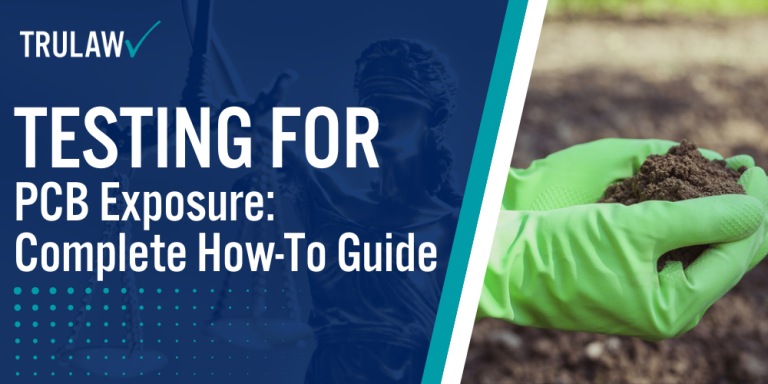
Intro to Testing For PCB Exposure
Polychlorinated Biphenyls (PCBs) are a group of man-made chemicals that were widely used in electrical equipment, heat transfer fluids, and as additives in paint, carbonless copy paper, and plastic products until their ban in the late 1970s due to environmental and health concerns.
Despite their ban, PCBs persist in the environment, posing significant health risks to humans and wildlife due to their ability to bioaccumulate and their potential to cause cancer, along with other adverse health effects.
If you or a loved one has experienced adverse health conditions after being exposed to PCB chemicals, you may be eligible to seek compensation.
Contact TruLawsuit Info today using the chat on this page to receive an instant case evaluation.
Table of Contents
Introduction to Testing for PCB Exposure
Polychlorinated Biphenyls (PCBs) are a group of man-made chemicals that were widely used in electrical equipment, heat transfer fluids, and as additives in paint, carbonless copy paper, and plastic products until their ban in the late 1970s due to environmental and health concerns.
Despite their ban, PCBs persist in the environment, posing significant health risks to humans and wildlife due to their ability to bioaccumulate and their potential to cause cancer, along with other adverse health effects.
Testing for PCB exposure is crucial for individuals who live in or have spent significant time in areas known for PCB contamination or those who have symptoms associated with PCB exposure.
Through TruLawsuit Info, a legal news website dedicated to providing the latest and most comprehensive information on chemical exposure lawsuits, readers can gain valuable insights into the process of testing for PCB exposure.
Our network of attorneys has extensive experience in handling complex chemical exposure lawsuits, including the PCB Exposure Lawsuit, Camp Lejeune Water Contamination Lawsuit, Roundup Weed Killer Lawsuit, and Paraquat Lawsuit, among others.
This wealth of experience underscores our commitment to helping those affected by chemical exposures understand their rights and legal options.
If you suspect you or a loved one has been exposed to PCBs, it’s critical to take action by testing for exposure.
In this comprehensive guide, we will walk you through the various aspects of testing for PCB exposure, from understanding the risks to interpreting test results and exploring legal avenues should you test positive.
Our goal is to arm you with the information needed to take the necessary steps towards safeguarding your health and legal rights.
Remember, if you’re concerned about PCB exposure and its potential impacts on your health, use the chat on the bottom of this page to discuss the details of your case with our team and see if you qualify for a PCB Exposure lawsuit today.
Understanding PCB Exposure
Polychlorinated Biphenyls (PCBs) are synthetic organic chemicals that feature two benzene rings bonded together and chlorinated to various degrees.
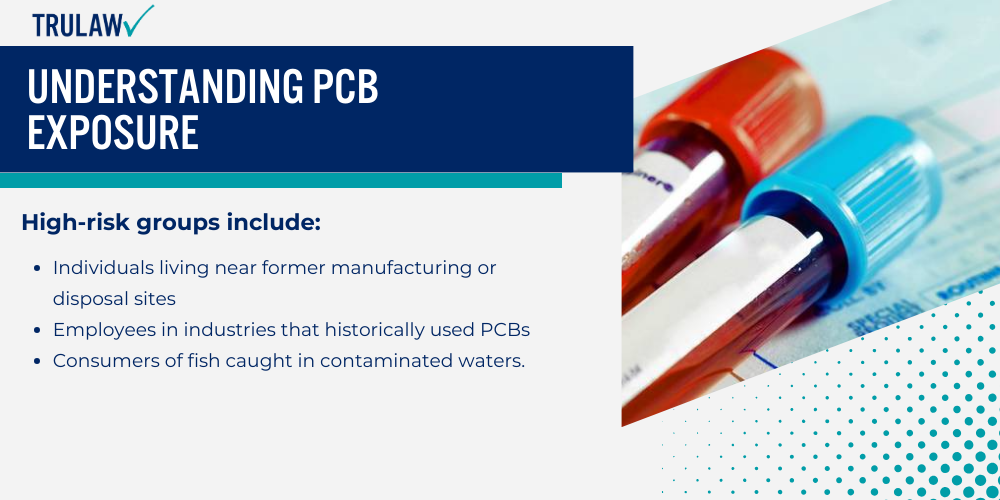
Their chemical stability, non-flammability, and insulating properties made them highly valued in industrial applications, including use in electrical transformers, capacitors, hydraulic systems, and as additives in paint, sealants, and plastics.
Commercial PCB Mixtures
Commercial PCB mixtures, often known by their brand names such as Aroclor in the United States, were tailored for a wide range of industrial applications based on their chlorine content.
The varying degrees of chlorination influenced the mixtures’ physical and chemical properties, making them suitable for uses ranging from electrical insulators to heat exchange fluids.
These mixtures, due to their versatility and effectiveness, became prevalent in countless products before the recognition of their environmental and health hazards led to a widespread ban.
Understanding the composition and use of these mixtures is key to recognizing potential PCB exposure sources.
The Ban and Environmental Persistence
However, due to their environmental persistence and bioaccumulative nature, the production of PCBs was banned in the United States in 1979 under the Toxic Substances Control Act (TSCA).
Despite this ban, the legacy of PCBs continues to haunt many environments.
PCBs do not easily break down and can remain in soil, air, water, and living organisms for decades.
This longevity has led to their widespread distribution across the globe, even in regions where they were never used, through processes like atmospheric transport and deposition.
Health Risks from PCB Exposure
The health risks associated with PCB exposure are significant and multifaceted.
The National Toxicology Program has stated that PCBs are probable human carcinogens, meaning they are likely to cause cancer in humans.
Exposure to PCBs can occur through ingestion of contaminated food, inhalation of air containing PCB vapors, or skin contact with contaminated materials.
Once in the body, PCBs accumulate in fat tissues, leading to long-term health issues.
The range of potential health effects includes skin conditions such as chloracne, liver damage, and various types of cancer.
Additionally, PCB exposure has been linked to immune, reproductive, nervous, and endocrine system disturbances.
High-Risk Groups and PCB Contaminated Fish
Recognizing the dangers of PCB exposure is the first step in protecting oneself and one’s community.
High-risk groups include:
- Individuals living near former manufacturing or disposal sites
- Employees in industries that historically used PCBs
- Consumers of fish caught in contaminated waters.
Eating contaminated fish or eating contaminated food (aside from fish) puts an individual at high risk of PCB exposure.
Understanding these risks and the pathways of exposure is essential for informed decision-making regarding health and safety.
The persistence of PCBs in the environment and their potential for causing serious health problems underline the importance of testing for exposure.
This is particularly crucial for those who suspect they have been in contact with PCB-contaminated materials or environments.
By identifying PCB exposure early, individuals can take steps to mitigate health risks and explore legal avenues to address any harm suffered due to exposure.
Legal Support from TruLawsuit Info for Polychlorinated Biphenyls Exposure Victims
Our network of attorneys at TruLawsuit Info has helped thousands of clients navigate the complexities of chemical exposure lawsuits, including those related to PCBs.
Our experience in this field is a testament to our dedication to supporting victims of chemical exposure and holding responsible parties accountable.
As we delve further into how to test for PCB exposure, remember that understanding your exposure risk is a critical component of protecting your health.
If you believe you’ve been exposed to PCBs, don’t hesitate to use the chat on the bottom of this page to discuss your case with our team and explore your legal options.
Legal Background on PCB Exposure
The legal landscape surrounding PCB exposure is complex, reflecting the widespread use of these chemicals before their ban and the long-term environmental and health impacts they have caused.
Over the years, numerous lawsuits have been filed against manufacturers of PCBs, entities responsible for environmental contamination, and corporations that failed to properly manage PCB-containing equipment or waste.
These legal actions have sought compensation for personal injuries, property damage, environmental remediation, and other losses attributed to PCB contamination.
One of the most notable legal cases involving PCBs was against Monsanto, the primary manufacturer of PCBs in the United States.
Plaintiffs have accused Monsanto of knowing about the dangers of PCBs long before they were banned but choosing to prioritize profits over public health and environmental safety.
Settlements and judgments in PCB litigation have often involved substantial financial compensation, highlighting the severity of the damage caused by PCB exposure and the accountability of those responsible.
TruLawsuit Info’s network of attorneys has a strong track record of representing clients in chemical exposure lawsuits, including those related to PCB exposure.
These cases often involve intricate legal and scientific issues, requiring specialized knowledge and expertise to navigate effectively.
Our network of attorneys has helped thousands of clients achieve justice in lawsuits similar to the PCB Exposure Lawsuit, such as the Camp Lejeune Water Contamination Lawsuit, Roundup Weed Killer Lawsuit, and Paraquat Lawsuit.
The success of these cases underscores the importance of legal recourse for individuals and communities affected by PCB exposure.
Legal action not only provides a means for victims to seek compensation for their suffering and losses but also plays a crucial role in holding polluters accountable and preventing future harm.
If you or a loved one has been affected by PCB exposure, it’s essential to understand your legal rights and options.
Our team at TruLawsuit Info is here to help. By using the chat on the bottom of this page, you can discuss the details of your case with our experienced team and see if you qualify for a PCB Exposure lawsuit today.
Taking legal action can be a powerful step towards achieving justice and ensuring that those responsible for PCB contamination are held accountable.
Who Should Test for PCB Exposure?
Identifying individuals and groups at higher risk for PCB exposure is crucial for preventing and mitigating health risks associated with these toxic chemicals.
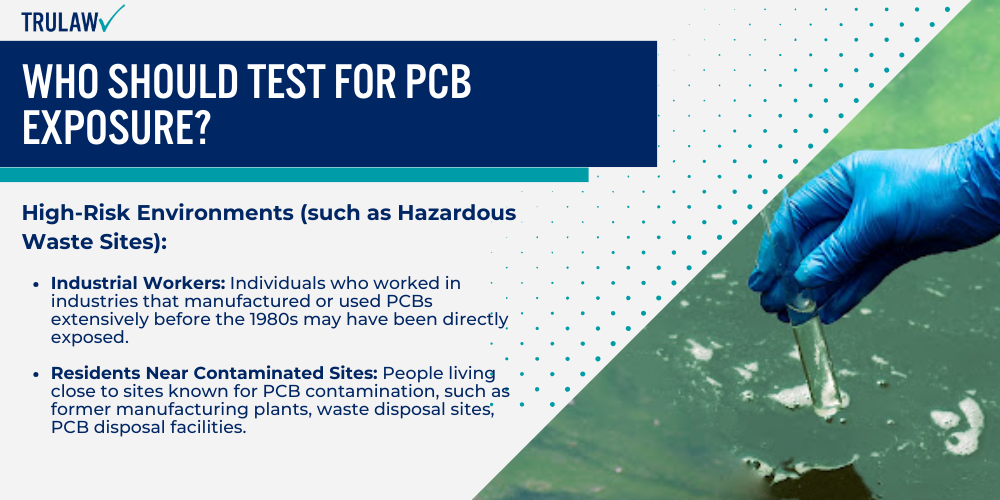
Given the widespread use of PCBs before their ban and their persistence in the environment, various populations may be at risk.
However, specific factors can increase the likelihood of exposure, making testing a prudent step for certain individuals.
High-Risk Environments (such as Hazardous Waste Sites)
- Industrial Workers: Individuals who worked in industries that manufactured or used PCBs extensively before the 1980s may have been directly exposed. Occupations in electrical repair, construction, and demolition of older buildings containing PCB-laden materials also pose significant risks.
- Residents Near Contaminated Sites: People living close to sites known for PCB contamination, such as former manufacturing plants, waste disposal sites, PCB disposal facilities, or areas with high levels of PCBs in soil or water bodies, are at increased risk of exposure.
- Individuals Who Have Consumed PCB Contaminated Fish and Wildlife: PCBs accumulate in the food chain. Regular consumption of fish or wildlife from contaminated areas can lead to significant PCB exposure.
- Individuals in Older Buildings: PCBs were used in caulking, sealants, and some types of paint in buildings constructed or renovated before the 1980s. Residents or workers in these buildings might be exposed to PCBs, especially during renovation or demolition activities.
Symptoms of PCB Exposure
Symptoms of PCB exposure can vary depending on the level and duration of contact.
Early signs might include skin rashes (such as chloracne), eye irritation, and respiratory symptoms.
Long-term exposure has been linked to more severe health issues, including liver damage, liver cancer, reproductive and developmental problems, immune system suppression, and potentially cancer.
It’s crucial for anyone experiencing these symptoms, particularly if they fit the high-risk categories, to consider testing for PCB exposure.
Importance of Testing
Testing for PCB exposure is an essential step for those at risk, providing necessary information for taking protective measures and seeking treatment if needed.
Early detection can also support legal actions, helping to establish a link between exposure and health conditions for those considering a lawsuit.
If you belong to one of these high-risk groups or have symptoms suggestive of PCB exposure, it’s important to take action.
TruLawsuit Info’s network of experienced attorneys is ready to support individuals affected by PCB exposure, guiding them through the complexities of legal claims and helping to secure just compensation.
Testing for PCB Exposure: An Overview
Understanding the various methods available for testing PCB exposure is essential for accurately assessing exposure levels and potential health risks.
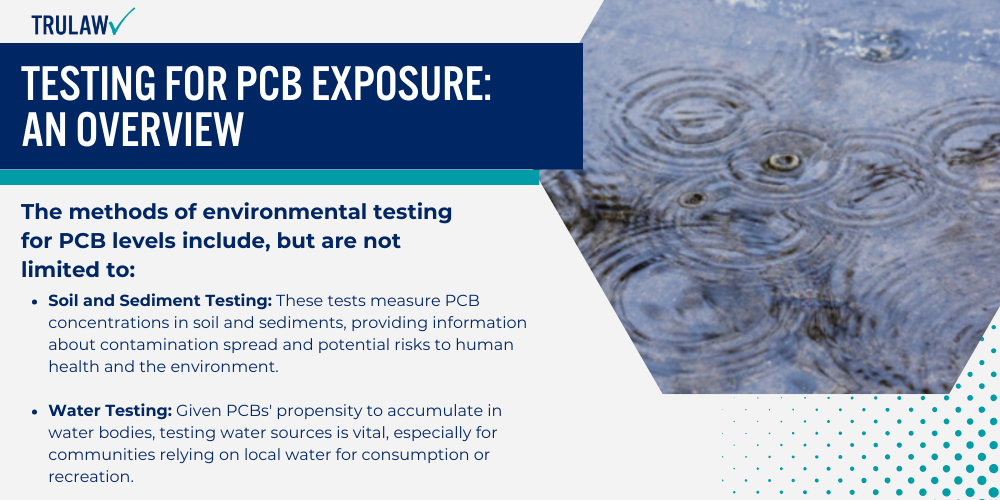
Both environmental and biological tests play critical roles in detecting PCB presence, helping individuals and communities make informed decisions about their health and legal actions.
Environmental Testing
Environmental testing focuses on measuring PCB levels in soil, water, air, and sediments to identify contamination sources and evaluate the risk of exposure.
These tests are crucial for regulatory agencies in assessing contaminated sites and for individuals living near potential PCB sources.
The methods of environmental testing for PCB levels include, but are not limited to:
- Soil and Sediment Testing: These tests measure PCB concentrations in soil and sediments, providing information about contamination spread and potential risks to human health and the environment.
- Water Testing: Given PCBs’ propensity to accumulate in water bodies, testing water sources is vital, especially for communities relying on local water for consumption or recreation.
- Air Quality Testing: PCBs can volatilize, becoming airborne, especially in areas with heavy contamination or during the removal of PCB-containing materials. Air quality tests can assess the inhalation risk of PCBs.
Biological Testing
Biological testing involves analyzing bodily fluids and tissues to detect PCB levels in the human body, offering direct evidence of exposure.
The following biological tests to analyze body fluids include, but are not limited to:
- Blood Tests: The most common form of biological testing for PCBs, blood tests measure levels of PCBs in the bloodstream, providing a snapshot of recent or ongoing exposure.
- Fat Tissue Biopsy: Given that PCBs accumulate in fat tissues, analyzing fat samples can offer insights into long-term exposure levels.
- Breast Milk Testing: For nursing mothers, testing breast milk can indicate PCB exposure levels, informing decisions about breastfeeding to protect infant health.
Interpreting Test Results
Interpreting test results requires expertise, as PCB levels can vary widely based on the type of exposure and individual factors.
Environmental and biological test results are compared to established safety thresholds to assess risk levels.
Health professionals and environmental experts can provide guidance on mitigating exposure risks and addressing health concerns based on these results.
Testing for PCB exposure is a critical step for those at risk.
It not only aids in understanding and managing health risks but also supports legal claims related to PCB contamination.
For individuals considering a lawsuit due to PCB exposure, documenting exposure levels through testing can be a pivotal piece of evidence in building a strong case.
At TruLawsuit Info, we emphasize the importance of testing for PCB exposure and understanding your legal rights if affected.
Our experienced network of attorneys are here to guide you through the process, offering support and expertise to those impacted by PCB contamination.
Step-by-Step Guide to Testing for PCB Exposure
Testing for PCB exposure involves several steps, from identifying the need for testing to interpreting the results and taking subsequent actions.
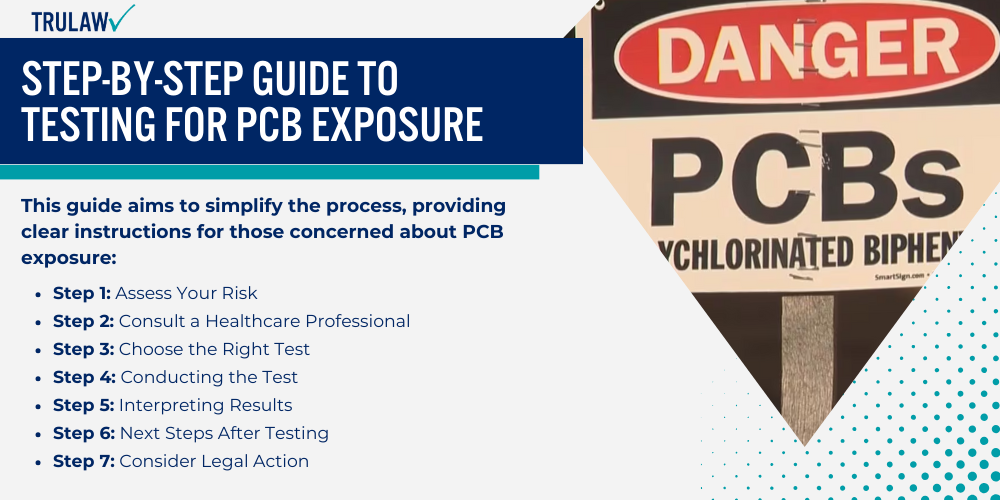
This guide aims to simplify the process, providing clear instructions for those concerned about PCB exposure.
Step 1: Assess Your Risk
- Identify Potential Exposure: Consider your living environment, occupation, and lifestyle. Are you in close proximity to known contaminated sites, industries that used PCBs, or older buildings? Have you consumed fish from potentially contaminated waters?
- Recognize Symptoms: Pay attention to any health symptoms that might be associated with PCB exposure, such as skin irritations, respiratory issues, or other long-term health changes.
Step 2: Consult a Healthcare Professional
- Before pursuing any testing, consult with a healthcare professional. They can advise on the necessity of testing based on your exposure risk and health symptoms.
- Discuss your concerns and symptoms, providing as much information about your potential exposure as possible.
Step 3: Choose the Right Test
- Environmental Testing: If you suspect your home or local environment is contaminated, consider hiring professionals to conduct soil, water, or air quality tests.
- Biological Testing: For personal exposure assessment, healthcare professionals may recommend blood tests, fat tissue biopsies, or other relevant tests to detect PCB levels in your body.
Step 4: Conducting the Test
- Environmental Tests: Contact environmental testing agencies or local health departments that can conduct or recommend services for PCB testing in your area.
- Biological Tests: Follow your healthcare provider’s instructions for testing. This may involve visiting a lab or hospital for blood samples or other procedures.
Step 5: Interpreting Results
- Once you receive your test results, consult with your healthcare provider and possibly an environmental health expert to understand what they mean. Results will be compared to standard guidelines to assess exposure levels.
- Understand that PCB levels in the environment or body are measured in parts per million (ppm) or parts per billion (ppb), and the significance of these levels can vary based on many factors.
Step 6: Next Steps After Testing
- Negative Results: If tests do not show elevated levels of PCBs, continue to monitor your health and environment. Remain informed about PCB exposure and prevention.
- Positive Results: Elevated levels of PCBs require action. Work with healthcare professionals to monitor your health and take preventive measures to reduce further exposure. This may involve dietary changes, medical monitoring, or modifications to your living or work environment.
Step 7: Consider Legal Action
- If your test results confirm significant PCB exposure, especially if it has adversely affected your health, consulting with a legal expert specializing in environmental contamination and chemical exposure cases can be an important step. Documenting your exposure and any related health issues is crucial.
- TruLawsuit Info’s network of experienced attorneys can provide the guidance and representation needed to pursue a lawsuit. They have a strong track record in handling cases related to chemical exposures, including PCBs.
What to Do If You Test Positive for PCB Exposure
Testing positive for PCB exposure can be alarming, but taking informed and strategic steps can help manage health risks and address potential legal claims.
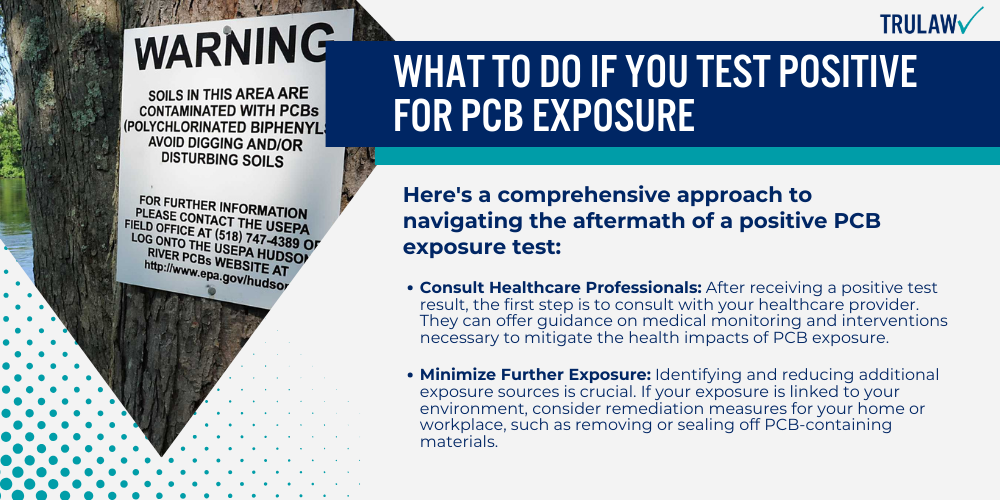
Here’s a comprehensive approach to navigating the aftermath of a positive PCB exposure test.
Immediate Actions
- Consult Healthcare Professionals: After receiving a positive test result, the first step is to consult with your healthcare provider. They can offer guidance on medical monitoring and interventions necessary to mitigate the health impacts of PCB exposure. This may include regular check-ups, blood tests, and specific treatments for symptoms or conditions related to PCBs.
- Minimize Further Exposure: Identifying and reducing additional exposure sources is crucial. If your exposure is linked to your environment, consider remediation measures for your home or workplace, such as removing or sealing off PCB-containing materials. If dietary sources are a concern, adjust your eating habits to avoid contaminated foods, particularly certain fish known to accumulate PCBs.
Legal Considerations
- Document Everything: Keep detailed records of your test results, medical consultations, symptoms, and any expenses related to PCB exposure. This documentation will be invaluable if you decide to pursue a legal claim.
- Explore Your Legal Options: PCB exposure cases often involve complex legal and scientific issues. Consulting with attorneys who specialize in environmental law and chemical exposure cases can provide clarity on your legal rights and the viability of a lawsuit. They can assess the specifics of your case, including the source of exposure, health impacts, and potential defendants.
Seeking Legal Representation
- Contact TruLawsuit Info: Our network of experienced attorneys is well-versed in handling PCB exposure lawsuits. With a deep understanding of the legal landscape surrounding chemical exposures, our team can guide you through the process of seeking justice and compensation. We can help evaluate your case, gather necessary evidence, and navigate the legal system on your behalf.
- Understand the Legal Process: Pursuing a legal claim for PCB exposure involves several steps, including filing a lawsuit, discovery (gathering evidence), and possibly going to trial. Settlements are also common, where the parties agree on compensation without a trial. Your attorney will be with you every step of the way, providing advice and advocacy.
How TruLawsuit Info Can Help
When facing the challenges of PCB exposure, knowing where to turn for help can make a significant difference.
TruLawsuit Info stands as a beacon for those navigating the complexities of potential legal action due to chemical exposures. Here’s how we can assist:
Expert Legal Network
Our network of attorneys specializes in chemical exposure lawsuits, including cases related to PCB exposure.
These legal professionals have a deep understanding of the intricacies involved in such cases, from the scientific evidence required to the legal strategies that can lead to successful outcomes.
Our attorney network has helped thousands of clients in situations similar to yours, securing justice and compensation for their suffering and losses.
Comprehensive Case Evaluation
We offer a thorough case evaluation to understand the specifics of your situation.
This includes assessing the extent of your exposure, the impact on your health, and the potential for holding negligent parties accountable.
Our team is dedicated to providing personalized attention, ensuring that your case receives the careful consideration it deserves.
Guidance Through the Legal Process
Navigating the legal system can be daunting, especially when dealing with the aftermath of PCB exposure.
Our network of attorneys guide clients through each step, from filing a lawsuit to negotiating settlements or representing your interests in court.
We aim to make the process as transparent and stress-free as possible, keeping you informed and involved at every stage.
Commitment to Justice and Accountability
At TruLawsuit Info, we are driven by a commitment to justice and accountability.
We believe that individuals and communities affected by PCB exposure deserve compensation for their hardships and measures to prevent further harm.
Our legal efforts extend beyond individual cases, contributing to broader environmental protection and public health initiatives.
Take the First Step
If you or a loved one has been exposed to PCBs and are considering legal action, TruLawsuit Info is here to help.
Use the chat on the bottom of this page to discuss the details of your case with our team and see if you qualify for a PCB Exposure lawsuit today.
Taking this step can be pivotal in securing your rights and contributing to a safer, healthier future for all.
Frequently Asked Questions
-
How toxic is PCB to humans?
PCBs, or polychlorinated biphenyls, are highly toxic to humans, impacting the thyroid, reproductive systems, and increasing the risk of heart, liver disease, and diabetes.
Exposure in women can result in low birth weight infants who face increased health risks. PCB toxicity is a significant concern for human health.
-
How toxic is PCB?
PCBs (polychlorinated biphenyls) are highly toxic chemicals classified as probable human carcinogens. Research demonstrates PCBs’ carcinogenic effects in animals, with supporting evidence of similar risks in humans.
As persistent environmental pollutants, PCBs pose significant health risks, reinforcing the critical need for safe-handling and proper disposal.
-
How do you treat PCB exposure?
To treat PCB exposure, immediately flush affected skin or eyes with plenty of water. Although there’s no specific treatment for PCB buildup in the body, it’s crucial to cease further exposure and avoid liver-damaging substances like alcohol.
Consult a healthcare professional for personalized advice and care following exposure.
-
What does PCBs stand for?
PCBs stand for Polychlorinated Biphenyls, which are synthetic organic chemicals used industrially and known for environmental contamination concerns.
These compounds belong to a larger group called chlorinated hydrocarbons, noted by the EPA for their persistence and potential health impacts.

Experienced Attorney & Legal SaaS CEO
With over 25 years of legal experience, Jessie is an Illinois lawyer, a CPA, and a mother of three. She spent the first decade of her career working as an international tax attorney at Deloitte.
In 2009, Jessie co-founded her own law firm with her husband – which has scaled to over 30 employees since its conception.
In 2016, Jessie founded TruLaw, which allows her to collaborate with attorneys and legal experts across the United States on a daily basis. This hypervaluable network of experts is what enables her to share reliable legal information with her readers!
Have A Case?
Here, at Tru Lawsuit Info, we’re committed to helping victims get the justice they deserve.
To do this, we actively work to connect them with attorneys who are experts in litigating cases similar to theirs.
Would you like our help?
Tru Lawsuit Info is a reliable source of information about issues that may affect your health and safety, such as faulty products, data breaches, and environmental hazards.
Our team of experienced writers collaborates with medical professionals, lawyers, and advocates to produce informative articles, guides, and other resources that raise awareness of these topics.
Our thorough research provides consumers with access to reliable information and updates on lawsuits happening around the country. We also can connect consumers with attorneys if they need assistance.
Camp Lejeune's water contamination issue spanned several decades starting in the 1950s. Exposure to these chemicals has been linked to various serious health issues, including cancer, organ diseases, and death.
Research is increasingly suggesting a link between the use of Tylenol during pregnancy and the development of neurodevelopmental disorders, such as autism and ADHD, in infants.
Legal action is being taken against manufacturers of Aqueous Film-Forming Foam (AFFF), a chemical used in fighting fires. The plaintiffs allege that exposure to the foam caused health issues such as cancer, organ damage, and birth and fertility issues.
Have A Case?
Here, at Tru Lawsuit Info, we’re committed to helping victims get the justice they deserve.
To do this, we actively work to connect them with attorneys who are experts in litigating cases similar to theirs.
Would you like our help?







